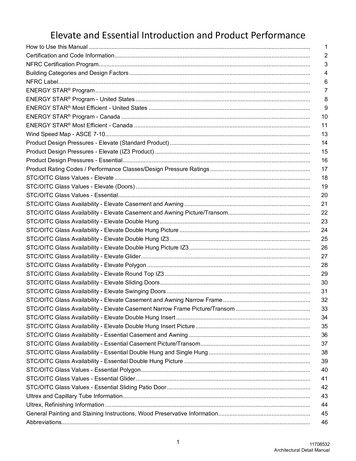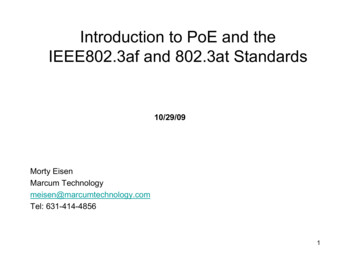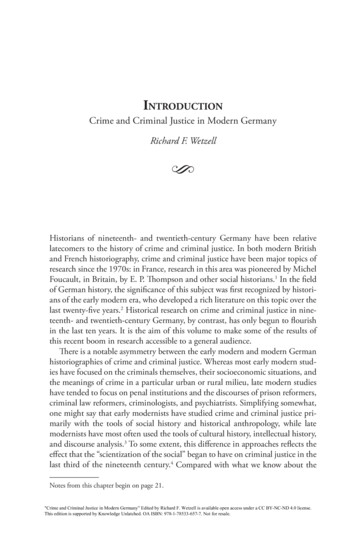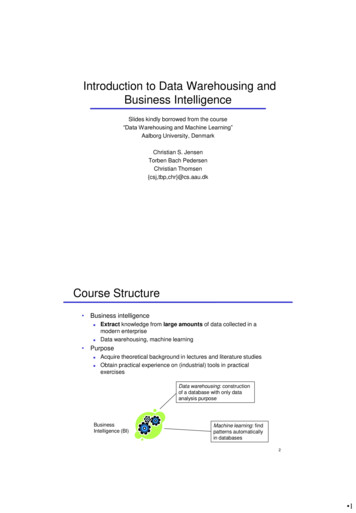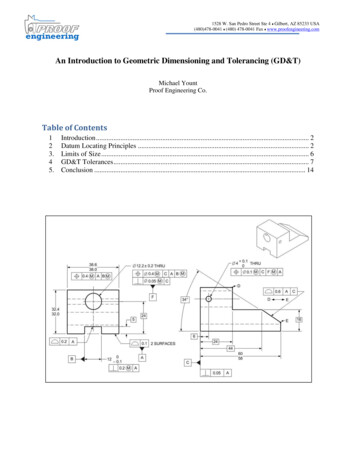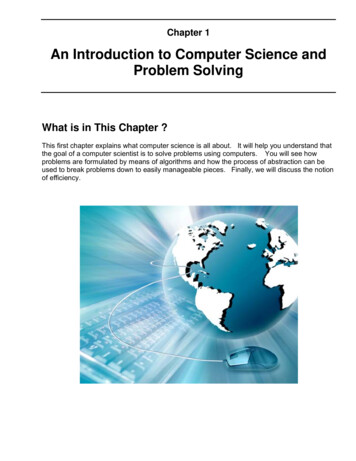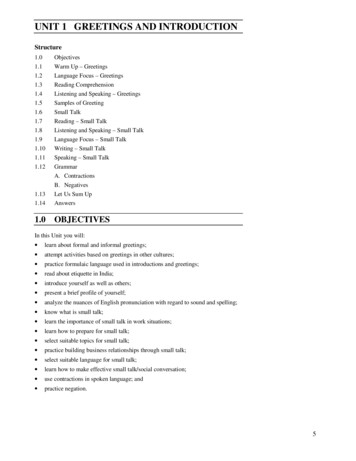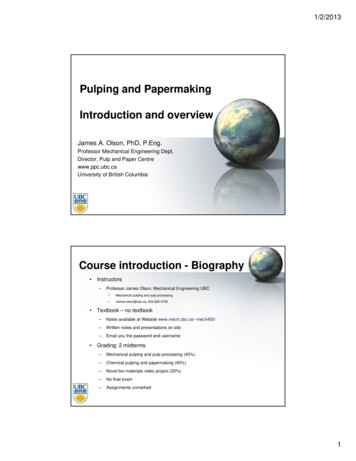
Transcription
1/2/2013Pulping and PapermakingIntroduction and overviewJames A. Olson, PhD, P.Eng.Professor Mechanical Engineering Dept.Director, Pulp and Paper Centrewww.ppc.ubc.caUniversity of British ColumbiaCourse introduction - Biography Instructors–Professor James Olson, Mechanical Engineering UBC Mechanical pulping and pulp processing James.olson@ubc.ca, 604.822-5705 Textbook – no textbook–Notes available at Website www.mech.ubc.ca/ mech450/–Written notes and presentations on site–Email you the password and username Grading: 2 midterms–Mechanical pulping and pulp processing (40%)–Chemical pulping and papermaking (40%)–Novel bio-materials video project (20%)–No final exam–Assignments unmarked1
1/2/2013Course outline IntroductionNatural resourceMechanical pulpingLow Consistency refiningSuspension rheologyScreeningCleaningChemical singPaper products Class Cancellations– No Classes Week of Feb 4.What is paper?“A thin flat surface usually made ofwood fibres.” Surface for communicatingtext and images– e.g. magazines, newspapers,books, brochures, . Surface to enclose, protectand carry– e.g. corrugated boxes, bags, shoeboxes, paper cups, . Surface to cover, absorb orstop fluids– e.g. hygiene grades, Kleenex, toiletpaper, paper towel, medicaltissues, .2
1/2/2013What inventions have fundamentallychanged our lives ? Early 14th century no one herewould know how to read! The Printing Press– Johann Gutenberg, Mainz, 1439 (MSN Encarta ranks it 3rd after theclock and the toilet) What did he print? New found literacy– Fed the renaissance– Created the scientific revolutionHistory of paper 3000BC Egypt made from papyrus3
1/2/2013History of paper 105 AD – Cai Lun (China) first to makecotton paper Bamboo paper was produced in the TangDynasty (608 – 907 AD) Korea in 300 AD Printing in 11th centuryEarly paper money 600ADHistory of paper First modern paper machine 1799 Patent issued to Nicholas-LouisRobert for first continuous papermaking machine (France) 1803 Patents issued to Fourdrinierbrothers for improved continuouspaper machine4
1/2/2013History of paper Pre-mid 1800’s paper was made fromwhat? 1841, Friedrick Keller “inventor” of themechanical pulping process for wood 1848 Johan Voith in Heidenheim madefirst commercial grinder. 1867 Full plant powered by steamPaper made with 70% wood– Worlds fair Paris 1868 Tampella (Finnish company)started making grinders.Modern Papermachine5
1/2/2013Paper - In the works!Our forestForests - Overview 27% of land mass is forested Annual world harvest is 3.5 B m 3– 50% fuel– 33% wood– 16% pulp and paper 6% of annual harvest is plantation but is 23% ofPulp and Paper Canada has 10% of worlds harvest Support 1.6% population increase requires forestthe size of BC6
1/2/2013Types of Trees Gymnosperms (Naked seed)– Conifers– Softwoods Angiosperms (Vessel – seed)– Deciduous– Hardwoods Name some species?Tree cross-section7
1/2/2013Different types of cellsCell Structure Primary Wall Secondary Wall:– S1 Layer:– S2 Layer– S3 Layer Middle Lamella:8
1/2/2013Chemical structure Cellulose– Glucose monomers– Primary wall 6000 units– Secondary 16000 units Hemi-celluloseOBAHOHOO– Poly-sacharidesOHOOHOH– Branched polymersHOOO– Eg, xylose, arabinoseEHOOC Micro-fibrils– Crystals of celluloseHOOHOHFiberHOODOHO– 20 nm 2000 cellulosemoleculesOHOHOOOHCellulose MoleculeSEM of paper cross section9
1/2/2013Paper – In the works!The Pine Beatle in BCIntroduction Pine Beetle– Attacks Lodge pole pines first– Can also attach Jack, Ponderosa,Western white, etc. Burrows under the tree bark andreproduces– Winter eggs mature into pupae– Fly off to new trees in the spring10
1/2/2013The Attack – Beatles burrow into thetree’s cambium layerThe Attack! – The tree defends itselfby pitching them out11
1/2/2013The Attack! – Chemical warfare.Blue stain fungus counters the pitchThe tree dies! Turns red in first years12
1/2/2013Tree turns grey in subsequent yearsHow big is this problem? 2005 area of infection 80% of BC pine is affected13
1/2/2013When will it end?– Hot dry summers andmild winters Plenty of food due to40 years of firesuppression Lack of earlymanagement Inaccessible hot spotsArea of susceptiblepine (M Ha) Climate change?MPB outbreak area (k Ha)How did it get so bad?19952005Winterminimumtemp ( -40C)14
1/2/2013What problems are we facing? Fire hazards– Communities, recreation, other species at risk Lost value– Forestry is 40% of our GDP in this province– Blue stain Darkens the chips used in paper Colors the wood / lumber– Grey trees are dry and crack Cant be sawn into lumber Difficult to pulp into paperWhat can we do about it? 50% increased wood harvest for 10 years,– More pine in fibre mix– Cheaper wood but lower quality– Build new sawmills to process wood into lumber Research into how to best utilize this resource Extensive replanting of mixed species forests15
1/2/2013Paper - in the works!The Industry in Canada / BCWorld paper production Globally increasingdemand for paper Decrease inprinting and writingbut increase intissue / packaging16
1/2/2013Consumption per capita Consumption closely tiedto standard of living– Why?Recyclable One of themost recycledmaterials Very highrecover rates.17
1/2/2013Canadian export What is largestexported product?Export industries in Canadahttp://en.wikipedia.org/wiki/Economy of CanadaWhere is pulp / paper made in BC? Mackenzie BC’s papermills are concentratedin the Southwest and North of theprovince These mills are usually the biggestsource of work in thesecommunities and directly employ17,000 people They are fed largely by unusedfibre from solid wood processingand collectively account for 4,280,000 in revenues and 20%of BC’s manufacturing economy With indirect jobs total BCemployment is about 50,000 people18
1/2/2013BC and Canada Forest Sector Revenues(CFS statistics):BC2010Canada2010BC Share2010 million 74%44771783325%66442025733%1100632717%Sawmills and wood preservation4450962846%Veneer, plywood and engineeredwood product manufacturing10934301Revenue from goodsmanufactured (dollars)Forestry and logging industryPulp and paper productmanufacturing industryConverted paper productmanufacturingPulp, paper and paperboard millsWood product manufacturingindustryOther wood productmanufacturingBC Working Group on Innovation - Sept 18, 20123725%BC Product Breakdown by Export 2011 (CFS statistics)Domestic exportsPrimary wood productsLogs and boltsPulpwoodWood chipsOther primary wood products (includes Christmas trees)Pulp and paper productsConverted paperNewsprintOther paper and paperboardOther paper productsRecovered paperWood pulpWood-fabricated materialsLumberOriented strandboardParticleboardPlywoodShingles and ShakesBC WorkingGroup on Innovation - Sept 18, 2012VeneerOther wood-fabricated materials (includes non- million9,83588856723392594 2781218974164723,1994,6693,8092943781333810319
1/2/2013Paper - In the Works!Pulp and paper technologyHow do we make paper?Pulping technology Two methods for converting wood to papermaking fibres Chemical (Kraft) Pulping– Uses chemical to dissolve lignin from wood to produce nearlypure cellulose fibres– 1 ton of tree 0.5 ton of paper– Strong, smooth, expensive Mechanical Pulping– Use grinders / refiners to separate fibres mechanically– 1 ton of tree 1 ton of paper– Low cost, opaque, weaker20
1/2/2013Modern kraft pulp millModern kraft pulp millCaCO3 heat CaO CO32000 t / dLignin / Cellulose / HemicelluloseComplex metabolites (Sterols/ fats/ etc)Cellulose / fibresNaOH Na2SCaO Na2CO3 H20 2NaOH CaCO3 heatLignin Na SNa2S Na2CO3Combined heat and electrical power (55 MW)660 kWh/t of pulp Hog Fuel boiler21
1/2/2013Modern mechanical pulp mill Fibres separated mechanically 30 MW motor How big is that? 42,000 HP In BC, 78 Motors thatconsume 11% of all theelectricity produced!(5,500 GWh/y)RecyclingA ton of paper made from recycled fibers conserves:7,000 gallonsof water17-31trees60 pounds4,000 KWhof electricity of air pollutants22
1/2/2013Modern papermacine 10 m wide100 m long1000 m/min. 400,000,000PressingSectionDrying SectionFormingSectionBC paper shipped to the world!23
1/2/2013A close up look at paperNewsprintA close up look at paperCopy paperMineralfillers (clay)24
1/2/2013A close up look at paperSupercalendered magazineA close up look at paperCoated magazine paper25
1/2/2013A close up look at paperSack paperA close up look at paperCoated board26
1/2/2013A close up look at paperLiner for orange juice containerMineralcoatingPolyethylenecoatingA close up look at paperCorrugated board27
1/2/2013A close up look at paperToilet paperEmbossingpatternA close up look at paperGrease proof paper28
1/2/2013The Future Pulp, Paper Forest Industry:The future forest bio-economy will be based onintegrated production of energy, fuel,chemicals, materialsForest bio-economy The bio-economy is transforming our world andour vision of the forest Forests provide truly renewable, sustainable,recyclable, climate neutral energy, fuel, chemicalsand materialsFPAC Bio-pathways analysis shows near future bioeconomy is estimated to be 200 Billion by 2015* Next generation industry is integration of Bio-energy / bio-fuel productionHigh value bio-chemicals and nutraceuticalsAdvanced materials and compositesNew fibre based products and building materialsSource: *FPAC – Bio Pathways29
1/2/2013Current bio-energy in BC More than 800 MW ofbiomass electricity installed(mostly P&P cogeneration) Growing pellet industry with2 Mt/y Several new ORC electricitygeneration installations 4 Nexterra gasificationsystems have been built 17 Million t/y forest biomassavailable for energy in BCwith additional 11Mt/y fornext 15 years 30% of current fossil F/BioEnergy Plan 005 0130 ip.ca/resource inventory.htmlProduct integration is key Forest based energy, fuel, chemicals,advanced materials are not economic as astand alone industry Integration of advanced bio-products withexisting industry is the near term key tosuccess Pulp and paper companies will be the earlyadopters of forest bio-economytechnologies Pre-existing, capital intensive systems: Biomass collection and handlingThermo-chemical conversionEnvironmental (air and water)‘Bolt-on’ technology for bio-energy, fuel,chemical and materials production iseconomic today30
1/2/2013Petroleum PathwaysBio-based Pathways – BioRefineryBC Working Group on Innovation - Sept 18, 201231
1/2/2013Diverse Biomass Derived Product OptionsMarket size / price for co-products derived from edSpecialty ChemicalsBiomass Aldehydes(Vanillin*, SA, anidins*Chitosan& derivatives104BioactivePolyphenolsChiral drugs310Maltol*102cis-3-HexenolTaxans*trans -2-Hexenal10110-1110102103104105Market price (US / kg)Source: “Thermochemical Strategies for Biofuels, GreenChemicals, Polymeric Biomaterials and Biofuels”, EstebanBC WorkingGroup on2005.Innovation - Sept 18, 2012Chornet,NovemberFuture bio-products All consumer products, including fuels, chemicals, materials,plastics, etc. can be made from forest bio-mass!We will learn about the exciting new bio-products through studentprojects / presentationsProject– Work in a group of 2-3 people– Choose a new bio-product that can be made from forest materials(example, carbon fibre car parts )– Develop a short video presentation that covers (5-7 minutes): The process of going from tree to bio-productThe properties of the materialThe estimated environmental impact (benefit).An economic reviewMarks awarded for interesting / artistic / entertainment value.– We will review all projects during class and videos will be graded byyour classmates.– Due (March 22nd)32
1/2/2013Thank You !33
James A. Olson, PhD, P.Eng. Professor Mechanical Engineering Dept. Director, Pulp and Paper Centre www.ppc.ubc.ca University of British Columbia. Course introduction -



